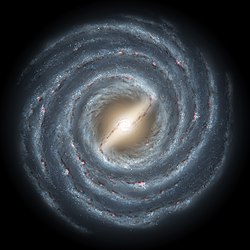Willman 1
| Galaxie Willman 1 | |
|---|---|
| AladinLite | |
| Sternbild | Großer Bär |
| Position Äquinoktium: J2000.0, Epoche: J2000.0 | |
| Rektaszension | 10h 49m 22,3s[1] |
| Deklination | 51° 03′ 03,6″[1] |
| Erscheinungsbild | |
| Morphologischer Typ | dSph/GC[1] |
| Helligkeit (visuell) | (15,2 ± 0,4) mag |
| Winkelausdehnung | (4,6 + 0,4 - 0,8)′[2] |
| Physikalische Daten | |
| Zugehörigkeit | Lokale Gruppe |
| Radialgeschwindigkeit | −13 km/s[3] |
| Entfernung | (120.000 ± 20.000) Lj / (38.000 ± 7.000) pc [2] |
| Absolute Helligkeit | ca. −3 mag[4] |
| Metallizität [Fe/H] | −2,1 |
| Geschichte | |
| Katalogbezeichnungen | |
| SDSS J1049+5103[1][5] | |
Willman 1 ist eine Ultralichtschwache Zwerggalaxie möglicherweise auch ein Kugelsternhaufen.[3] Sie wurde benannt nach Beth Willman vom Haverford College, der führenden Autorin einer Studie basierend auf Daten des Sloan Digital Sky Survey. Die Galaxie ist ein Trabant der Milchstraße und etwa 120 kpc entfernt.[1] Willman 1 besitzt eine elliptische Form mit einem Halblichtradius von etwa 25 pc[2] und einer heliozentrischen Fluchtgeschwindigkeit von näherungsweise −13 km/s.[3]
Eigenschaften
Stand des Jahres 2011 ist Willman 1 die zweitlichtschwächste bekannte Zwerggalaxie nach Segue 1. Sie beträgt lediglich ein 10 Millionstel der Leuchtkraft der Milchstraße. Die Galaxie hat eine absolute Helligkeit von −3 mag. Beobachtungen deuten darauf hin, dass sie eine Masse von 400.000 M⊙ besitzt. Damit kommt man zu einem Masse-Leuchtkraft-Verhältnis von rund 800,[3] was eine Dominanz dieser Galaxie durch Dunkle Materie impliziert. Es ist jedoch schwierig, besonders bei derart lichtschwachen Objekten, die Gesamtmasse des Systems abzuschätzen, da immer ein stabiles gravitativ gebundenes System als Rechengrundlage angenommen wird, was bei Galaxien, die gerade dem äußeren Einfluss von Gezeitenkräften ausgesetzt sind, nicht immer zutrifft.[3]
Willman 1 setzt sich primär aus älteren Sternen zusammen, die vor mehr als 10 Milliarden Jahren entstanden.[1] Die Metallizität dieser Sterne fällt entsprechend gering aus mit [Fe/H] ≈ −2,1, was gleichbedeutend ist damit, dass sie etwa 110 mal weniger an schweren Elementen als unsere Sonne enthält.[3]
Einzelnachweise
- ↑ a b c d e Beth Willman, Michael R. Blanton, Andrew A. West, Julianne J. Dalcanton, David W. Hogg, Donald P. Schneider, Nicholas Wherry, Brian Yanny u. a.: A New Milky Way Companion: Unusual Globular Cluster or Extreme Dwarf Satellite? In: The Astronomical Journal. Band 129, Nr. 6, 2005, S. 2692–2700, doi:10.1086/430214, arxiv:astro-ph/0410416, bibcode:2005AJ....129.2692W (englisch).
- ↑ a b c N. F. Martin, J. T. A. De Jong, H. W. Rix: A Comprehensive Maximum Likelihood Analysis of the Structural Properties of Faint Milky Way Satellites. In: The Astrophysical Journal. Band 684, Nr. 2, 2008, S. 1075, doi:10.1086/590336 (englisch).
- ↑ a b c d e f Beth Willman, Marla Geha, Jay Strader, Louie Strigari, Josh Simon, Evan Kirby, Ho West, Warres Nhung u. a.: Willman 1—A Probable Dwarf Galaxy with an Irregular Kinematic Distribution. In: The Astronomical Journal. Band 142, Nr. 4, Oktober 2011, S. 128, doi:10.1088/0004-6256/142/4/128, arxiv:1007.3499, bibcode:2011AJ....142..128W (englisch).
- ↑ (15,2 ± 0,4) mag scheinbare Helligkeit − 5 * log10((38.000 ± 7.000) pc / 10 pc) → −2,7 mag absolute Helligkeit
- ↑ NED Results for SDSS J1049+5103. Jet Propulsion Laboratory, California Institute of Technology, under contract with the National Aeronautics and Space Administration, 9. Januar 2007, abgerufen am 28. Dezember 2012 (englisch).
Auf dieser Seite verwendete Medien
Caption from NASA: Like early explorers mapping the continents of our globe, astronomers are busy charting the spiral structure of our galaxy, the Milky Way. Using infrared images from NASA's Spitzer Space Telescope, scientists have discovered that the Milky Way's elegant spiral structure is dominated by just two arms wrapping off the ends of a central bar of stars. Previously, our galaxy was thought to possess four major arms.
This artist's concept illustrates the new view of the Milky Way, along with other findings presented at the 212th American Astronomical Society meeting in St. Louis, Mo. The galaxy's two major arms (Scutum-Centaurus and Perseus) can be seen attached to the ends of a thick central bar, while the two now-demoted minor arms (Norma and Sagittarius) are less distinct and located between the major arms. The major arms consist of the highest densities of both young and old stars; the minor arms are primarily filled with gas and pockets of star-forming activity.
The artist's concept also includes a new spiral arm, called the "Far-3 kiloparsec arm," discovered via a radio-telescope survey of gas in the Milky Way. This arm is shorter than the two major arms and lies along the bar of the galaxy.
Our sun lies near a small, partial arm called the Orion Arm, or Orion Spur, located between the Sagittarius and Perseus arms.
